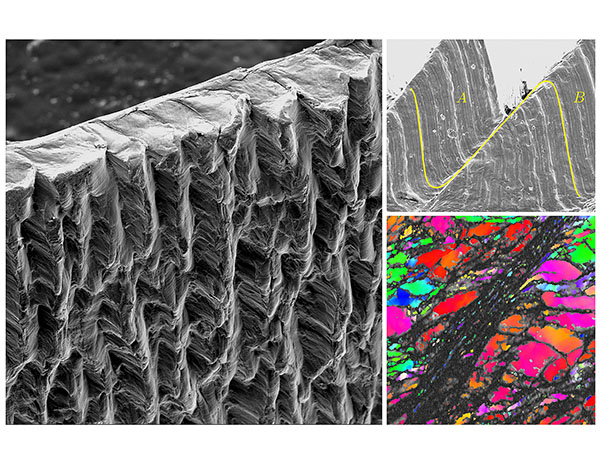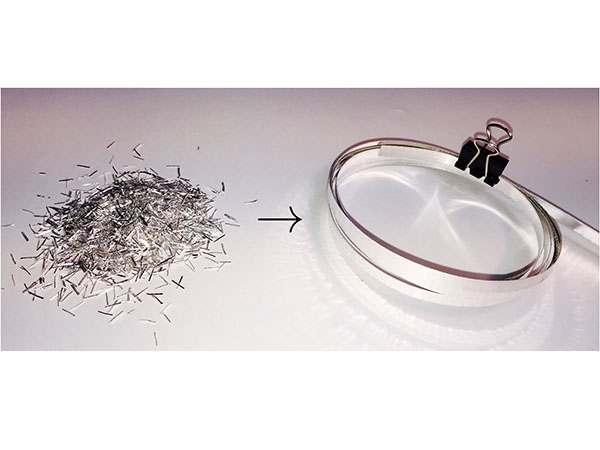September 21, 2016
Researchers control 'shear-band' defects in manufacturing processes

The formation of "shear bands" has been a long-standing problem in metals manufacturing processes. The phenomenon is seen in the electron microscope image at left as a wavy saw-toothed structure in a peeled strip of titanium. At right top, the researchers traced a "micromarker" across a shear band, highlighted in yellow. At bottom right an electron back scatter image reveals the band as a severely deformed, dark featureless region about four micrometers thick. (Purdue University image/Center for Materials Processing and Tribology)
WEST LAFAYETTE, Ind. – An international team of researchers has invented a method to control the formation of defects called "shear bands" in metals manufacturing processes and discovered microscopic details of how the defects are created.
Shear banding occurs often in high-speed machining of structural metals. It has been a long-standing problem in manufacturing processes because it hinders production of good quality surfaces while machining advanced metal alloys like titanium, nickel and high-temperature aerospace materials, and in the production of metal sheets and foils, according to Srinivasan Chandrasekar, a Purdue University professor of industrial engineering and Kevin P. Trumble, a professor of materials engineering.
"This new work, based on a fundamental understanding of how shear bands form, is an important advance for manufacturing and metals processing," said Chandrasekar, director of Purdue's Center for Materials Processing and Tribology.
The research has revealed that the shear bands form in two phases, said Purdue postdoctoral research associate Koushik Viswanathan.
First, a "weak interface" is created as the metal is being cut, and then the metal shears at this interface, producing a saw-tooth pattern.
"More importantly, we have learned how to suppress the formation of shear bands using a simple method," said lead author Dinakar Sagapuram, a former Purdue postdoctoral research associate who recently joined Texas A&M University as an assistant professor.
Findings are detailed in a paper published online in August in the Proceedings of the Royal Society A, and featured on the cover of the September print edition of the journal. The paper is available online at http://rspa.royalsocietypublishing.org/content/472/2192/20160167.
 An international team of researchers has invented a method to control the formation of defects called "shear bands" in metals manufacturing processes. At left, the defects create chips of needle-shaped particles. At right, the new method eliminates the shear banding, resulting in a long continuous strip. (Purdue University image/Center for Materials Processing and Tribology)
Download image
An international team of researchers has invented a method to control the formation of defects called "shear bands" in metals manufacturing processes. At left, the defects create chips of needle-shaped particles. At right, the new method eliminates the shear banding, resulting in a long continuous strip. (Purdue University image/Center for Materials Processing and Tribology)
Download image
The phenomenon of shear-band formation exists in many settings, from the nearly atomic scale in "metallic glasses," to the millimeter scale in machined metals and to kilometer-size defects seen in rocks that undergo sliding in the earth's crust.
The "displacement profiles" of shear bands resemble those created in liquids flowing past an interface. Because of this similarity, the researchers applied mathematical equations customarily used to analyze viscous fluid flow to analyze the formation of the shear bands. The fluid-like behavior is mysterious because it is unclear whether the metals being processed heat up enough to actually become liquid.
"The temperatures generated in these shear bands have been estimated from a few hundred Celsius to a few thousand Celsius, so this is really an unknown," Viswanathan said.
The first phase of the band formation occurs within just a few microseconds.
"The second phase is where the metal slides along a thin weak interface," Sagapuram said. "This phase is somewhat more gradual and surprisingly exhibits a viscous-like behavior."
The suppression method works by adding a wedge-shaped die opposite the cutting tool, so that the chip from the metal being machined is channeled between the two. The additional tool constrains the metal to deform more uniformly and eliminates the viscous sliding phase. Because of its simplicity, the method is practical for use in industry.
"You can think of it as the tool consisting of two parts, one doing the cutting and other doing the constraining," said Chandrasekar, also a professor of materials engineering.
The paper was authored by Sagapuram, Viswanathan, Chandrasekar and Trumble; Anirban Mahato, an assistant professor at the Indian Institute of Technology, Patna; Narayan K. Sundaram, an assistant professor at the Indian Institute of Science; and Rachid M'Saoubi, a research manager at Seco Tools Ltd. in the United Kingdom.
The researchers studied the deformation by taking images of marks etched into the metal beforehand. As the metal is processed, the groove-like "micromarkers" reveal the large and serrated deformations.
"The markers basically tell you if the deformation is homogeneous or not, and also how much deformation the material has locally undergone near the shear band defects," Trumble said.
The shear bands form parallel, intensely deformed striations and may cause the metal to break into fragments small enough to produce a powder-like pile of chip shavings. Metals like titanium and magnesium, which have a hexagonal close-packed crystal structure, are particularly prone to the shear band formation. However, the bands can form also in other metals that do not have this crystal structure, including brass, copper, steels and superalloys.
Several patent applications related to the research were filed through the Purdue Research Foundation's Office of Technology Commercialization.
The work was funded by the U.S. Department of Energy, U.S. Army Research Office and National Science Foundation.
Writer: Emil Venere, 765-494-4709, venere@purdue.edu
Source: Srinivasan Chandrasekar, 765-494-3623, chandy@purdue.edu
Note to Journalists: A copy of the research paper is available online at http://rspa.royalsocietypublishing.org/content/472/2192/20160167 and by contacting pnasnews@nas.edu, 202-334-1310, or Emil Venere at Purdue, 765-494-4709, venere@purdue.edu.
ABSTRACT
Geometric flow control of shear bands by suppression of viscous sliding
DinakarSagapuram1,†,KoushikViswanathan1, Anirban Mahato1,‡,Narayan K. Sundaram2, Rachid M’Saoubi3, Kevin P. Trumble1and Srinivasan Chandrasekar1 1Center for Materials Processing and Tribology, Purdue University, West Lafayette, IN,USA; 2Department of Civil Engineering, Indian Institute of Science, Bangalore, India; 3Seco Tools (UK) Ltd.
Shear banding is a plastic flow instability with highly undesirable consequences for metals processing. While band characteristics have been well studied, general methods to control shear bands are presently lacking. Here, we use high-speed imaging and micromarker analysis of flow in cutting to reveal the common fundamental mechanism underlying shear banding in metals. The flow unfolds in two distinct phases: an initiation phase followed by a viscous sliding phase in which most of the straining occurs. We show that the second sliding phase is well described by a simple model of two identical fluids being sheared across their interface. The equivalent shear band viscosity computed by fitting the model to experimental displacement profiles is very close in value to typical liquid metal viscosities. The observation of similar displacement profiles across different metals shows that specific microstructure details do not affect the second phase. This also suggests that the principal role of the initiation phase is to generate a weak interface that is susceptible to localized deformation. Importantly, by constraining the sliding phase, we demonstrate a material agnostic method—passive geometric flow control— that effects complete band suppression in systems which otherwise fail via shear banding.

